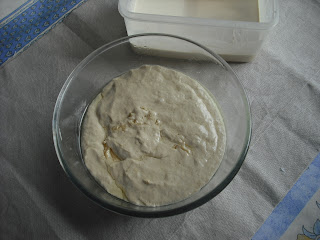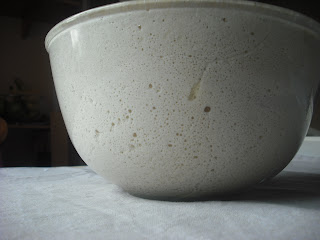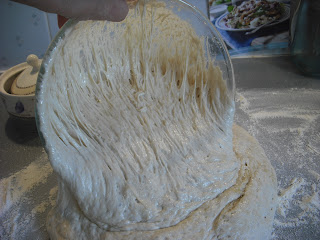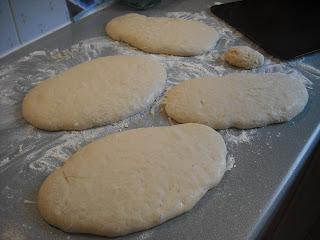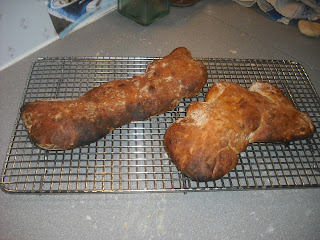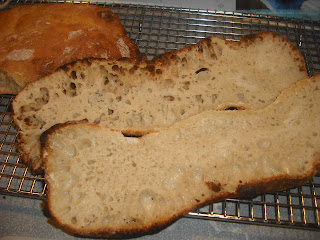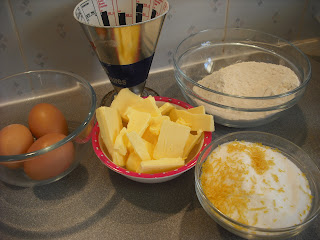As I sit here, having coffee, reading Christmas food blogs and eating Christmas cake, I am declaring the end of Christmas for me. I've even put a few decorations back in the box that are in the way - I don't usually do this until Epiphany, but I've had my epiphany and that is I'm over Christmas this year.
Ive lost my baking mojo and love of recipe flipping and I think it's because I got a flu-cold just before Christmas and then chopped my left index finger nearly in half on Christmas day, and because I miss my family who are thousands of miles away, and the weather has been lousy here. Rain, rain, rain, rain.
Even my Stir-Up Sunday effort last month was a bit of a failure. Overall, I used too much Captain Morgan's and lighting of the pudding took nearly half an hour to put out after the warmed brandy was poured over it. The cake, which I am eating now, tastes great but again, a little too much liquid has produced more of a pudding than cake. And the mince pies. I have been making mince pies for years but I am OVER mince pies and I only made 2 dozen this year. First batch for the freezer never made it there, and I didn't like the pastry I'd made. Second batch I used Jamie's idea of puff pastry and filo pastry but I didn't put enough fruit mince in so the overall texture was too doughy and some are still lurking in the tin and actually, the rest of the mincemeat I am going to throw out because it simply isn't that good.
I am pleased that at least the turkey is all eaten, because I only bought a crown this year, and the beef en croute was eaten in its entirety at Christmas dinner. It was delicious, (thanks Delia). We had had the ham in mustard and marmalade glaze the night before with new potatoes and cabbage, so the ham was added to Christmas dinner for those that didn't eat the beef. The bread sauce was lacking in flavour this year, don't know why and the cranberry was a little tart. I did manage, before the finger-slicing episode, to make a few jars of Christmas chutney from my new book Scandinavian Christmas, bt Trine Hahnemann. It is delicious and, of course, goes with all the cold leftovers.
Which is how I am feeling today. Like a cold leftover. Now there's New Year's Eve to get through but in reality, it's usually a non-event. I always love the idea of me and hubs alone having our own private NYE cocktail and nibbles party. I usally make some effort with pate and canapes.
Roll on 2013.
Saturday, 29 December 2012
Tuesday, 27 November 2012
Stir-up Sunday, 25th November
For the very first time EVER I managed to make the Christmas pudding, Christmas cake and fruit mince for mince pies ahead of time. Not only that, I made them on the traditional designated day in England which is called Stir-up Sunday.
I used an old family recipe from my Irish grandmother which I remember watching her make when I was a little girl. She would let me stir the pudding for luck. As I grew older, the making of the pudding was handed to me when my grandmother was too frail, and then she would watch me make it. After my mother died and when I moved overseas my Dad took over the puding-making and so wrote the recipe out again as the old one was almost illegible. His contribution came in the form of alcoholic content (he was well qualified), as is evidenced by his careful notes that the fruit had to be soaked in rum. Dad died a few years ago, but last year I went home for Christmas, and my brother and I decided to resurrect the family pudding. We had great fun shopping for the exact ingredients in the recipe, including Captain Morgan's Jamaican rum.
So making this pudding has lovely memories for me, and it really does feel like a family tradition is being kept alive. I know my sister and other brother all make it for their families too.
The most time-consuming part, however, is wrapping the darn thing up in paper and foil so it doesn't get water logged whilst steaming. And on your own is a devil of a job!
It is a small pudding this year, so it has been steamed for only 2 hours, and the another 2 hours on Christmas day, instead of the usual 4. I can't believe we used to actually have this simmering on the stovetop for 4 hours on an Australian Christmas day.
I don't have a traditional family cake recipe but have used this one for a couple of years now (usually because I make it Christmas Eve!) but the Christmas cake from The Australian Women's Weekly, Cakes & Cupcakes, is quick and really delicious. I somehow only managed one photo when I made this but the cake is still in its wrapper and I'll post more photos when it's iced yet.
Guess who's feeling extremely smug, then?
I used an old family recipe from my Irish grandmother which I remember watching her make when I was a little girl. She would let me stir the pudding for luck. As I grew older, the making of the pudding was handed to me when my grandmother was too frail, and then she would watch me make it. After my mother died and when I moved overseas my Dad took over the puding-making and so wrote the recipe out again as the old one was almost illegible. His contribution came in the form of alcoholic content (he was well qualified), as is evidenced by his careful notes that the fruit had to be soaked in rum. Dad died a few years ago, but last year I went home for Christmas, and my brother and I decided to resurrect the family pudding. We had great fun shopping for the exact ingredients in the recipe, including Captain Morgan's Jamaican rum.
So making this pudding has lovely memories for me, and it really does feel like a family tradition is being kept alive. I know my sister and other brother all make it for their families too.
| The family Christmas pudding |
The most time-consuming part, however, is wrapping the darn thing up in paper and foil so it doesn't get water logged whilst steaming. And on your own is a devil of a job!
| Pudding sealed and ready for the pot |
I don't have a traditional family cake recipe but have used this one for a couple of years now (usually because I make it Christmas Eve!) but the Christmas cake from The Australian Women's Weekly, Cakes & Cupcakes, is quick and really delicious. I somehow only managed one photo when I made this but the cake is still in its wrapper and I'll post more photos when it's iced yet.
| Christmas cake |
Guess who's feeling extremely smug, then?
Sunday, 21 October 2012
Mojito Genoise
Mojito Genoese
Baking Made Easy, Lorraine Pascale
This is a Genoese cake, but with a lovely limey/rum buttercream filling. Something different, something very delicious.
Sponge ingredients:
Then whisked for at least five minutes over a simmering pan for a nice ploppy dough consistency. This was put into my cake tin, lined with old butter papers (as I had run out of parchment paper). I have learned never to bake a cake without parchment paper!
And the cake was moist, zesty and a good celebratory cake which I'll make again.
Baking Made Easy, Lorraine Pascale
This is a Genoese cake, but with a lovely limey/rum buttercream filling. Something different, something very delicious.
Sponge ingredients:
Then whisked for at least five minutes over a simmering pan for a nice ploppy dough consistency. This was put into my cake tin, lined with old butter papers (as I had run out of parchment paper). I have learned never to bake a cake without parchment paper!
So after I had made two of these cakes, the buttercream was made of icing sugar, butter, lime juice as well as zest and some lovely white rum:
Unfortunately I forgot to take a photo of the buttercream-filled and iced cake, but I put them in the fridge to set until I had my fondant icing made. I had some yellow flowers I had made last year in a box and added them to the blue daisies bought online. I was quite pleased with the colours.
And the cake was moist, zesty and a good celebratory cake which I'll make again.
Wednesday, 3 October 2012
ciabatta
ciabatta
The Italian Cookery Course, Katie Caldesi
I was inspired to try ciabatta from Katie Caldesi's The Italian Cookery Course. As she says, ciabatta is literally translated as 'slipper bread' and originates from Como.
I had some dough ready to bake a few weeks ago and when I discovered my oven was broken (arrghhh!), I put the dough into a plastic box, placed the lid on and put it in the fridge. For three weeks.
I took out the dough today and thought I would have a go at incorporating it into ciabatta which requires a 'starter', mother dough or biga. A 'starter' is also used in sourdough. It's called a starter because it is used in place of yeast, which starts the fermenting process necessary to make the dough rise. It is just flour and water left to ferment using the natural yeasts in the air. This fermentation process also gives the finished bread product a lovely yeasty flavour, which is not present in commercially produced bread.
Here is my dough (starter in the background newly 'fed' with flour and water) ready for proving.
Here is the dough after an hour and a half. Look at the bubbles in that starter!
and all the bubbles in the ciabatta dough:
The dough was put onto a floured surface, made into a rectangle and then cut into four. This was very difficult. The dough was so wet that it just poured out of the basin.
I had no choice but to leave the four mounds of dough on the bench to prove for another 1.5 hours.
These were 'placed' (read scraped off the bench and plopped) onto two pre-heated baking sheets and put into a very hot 220 deg C oven for approx 20 mins.
Here are two:
I think the oven was too hot. Anyway, the cut open top loaf looked like this:
There are issues here.
1. over-cooked on the top
2. holes are not uniform throughout the loaf
3. some areas are quite dense
Flavour-wise, though, it was good. It was chewy, as it should be and the nice sour notes from the biga came through, so that was good.
I'll try this again soon, as the family sort of devoured the rest of the ciabatta, especially after I added chopped garlic and parsley and olive oil and cooked it in the oven. It was delicioso.
The Italian Cookery Course, Katie Caldesi
I was inspired to try ciabatta from Katie Caldesi's The Italian Cookery Course. As she says, ciabatta is literally translated as 'slipper bread' and originates from Como.
I had some dough ready to bake a few weeks ago and when I discovered my oven was broken (arrghhh!), I put the dough into a plastic box, placed the lid on and put it in the fridge. For three weeks.
I took out the dough today and thought I would have a go at incorporating it into ciabatta which requires a 'starter', mother dough or biga. A 'starter' is also used in sourdough. It's called a starter because it is used in place of yeast, which starts the fermenting process necessary to make the dough rise. It is just flour and water left to ferment using the natural yeasts in the air. This fermentation process also gives the finished bread product a lovely yeasty flavour, which is not present in commercially produced bread.
Here is my dough (starter in the background newly 'fed' with flour and water) ready for proving.
Here is the dough after an hour and a half. Look at the bubbles in that starter!
and all the bubbles in the ciabatta dough:
The dough was put onto a floured surface, made into a rectangle and then cut into four. This was very difficult. The dough was so wet that it just poured out of the basin.
I had no choice but to leave the four mounds of dough on the bench to prove for another 1.5 hours.
These were 'placed' (read scraped off the bench and plopped) onto two pre-heated baking sheets and put into a very hot 220 deg C oven for approx 20 mins.
Here are two:
I think the oven was too hot. Anyway, the cut open top loaf looked like this:
There are issues here.
1. over-cooked on the top
2. holes are not uniform throughout the loaf
3. some areas are quite dense
Flavour-wise, though, it was good. It was chewy, as it should be and the nice sour notes from the biga came through, so that was good.
I'll try this again soon, as the family sort of devoured the rest of the ciabatta, especially after I added chopped garlic and parsley and olive oil and cooked it in the oven. It was delicioso.
Wednesday, 15 August 2012
Happy Birthday, Julia
The great lady and doyenne of American cooking, Julia Child, would have been 100 today.
I was first made aware of Julia Child when my favourite 'cooking aunt' gave me Volume 1 of Mastering the Art of French Cooking as an engagement present. Newly married, I decided to randomnly make the beef bourgignon. My new husband thought that all our meals were going to be as good as my first efforts making his favourite dish. After that, I cooked a lot from these books and it really was as if she was there as a helping hand, teaching me and instilling a delight in how food was meant to be cooked correctly.
Fast foward a few years, a few moves (of country) and my beloved Volume 1 was stored away. Then, a couple of years ago I was browsing through a second-hand/charity shop for any good cookbook finds. Can you imagine how I felt when I suddenly saw on the shelf in front of me, a boxed set of original Mastering the Art of French Cooking, Volume 1 and Volume 2. Can you imagine???? My heart started thumping. I couldn't believe it. In almost perfect condition (save one page which had obviously had hot butter splattered across two pages) I took down the box and promptly went and paid a mere £10 for them. What a bargain!!!!
I continue to cook from these books today, and still learn from Julia's timeless instructions and attention to detail. She wanted to know how and why things happened with food. She was a girl after my own heart.
Happy Birthday, Julia.
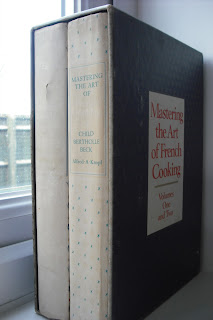 |
| MAFC - I found this in a charity shop |
Fast foward a few years, a few moves (of country) and my beloved Volume 1 was stored away. Then, a couple of years ago I was browsing through a second-hand/charity shop for any good cookbook finds. Can you imagine how I felt when I suddenly saw on the shelf in front of me, a boxed set of original Mastering the Art of French Cooking, Volume 1 and Volume 2. Can you imagine???? My heart started thumping. I couldn't believe it. In almost perfect condition (save one page which had obviously had hot butter splattered across two pages) I took down the box and promptly went and paid a mere £10 for them. What a bargain!!!!
I continue to cook from these books today, and still learn from Julia's timeless instructions and attention to detail. She wanted to know how and why things happened with food. She was a girl after my own heart.
Happy Birthday, Julia.
Saturday, 12 May 2012
le quartre quarts
A classic, a perfect place to start blogging about cake and, my favourite of all cakes. Otherwise known as pound cake or a yellow butter cake, it is the base from which a lot of cakes are made. This cake uses these ingredients :
This method creams the butter into a smooth cream first to then set aside. Add the eggs and sugar with lemon rind and whip for a good 4-5 minutes. The sifted flour is mixed in briefly, and lastly the butter is incorporated into the egg mixture - again only briefly. The batter is poured into a 20cm cake tin, which has been lined with parchment paper, and then cooked for approximately 35 minutes.
For the cake today I made a creme au citron, or lemon cream. For this recipe I put icing sugar, lemon juice, lemon rind, hot water, 1 egg, a tablespoon of cornstarch into a saucepan and heated, whilst continually whisking. Off the heat, with further whisking the mixture thickens into a smooth translucent looking cream, with the addition of more butter.
After cooling the cake was cut in half, spread with lemon cream on the bottom layer and then sandwiched, topped off with a thin layer of lemon cream on the top.
As you can see, the middle sank slightly, which is a FAIL. Either the temperature was not hot enough or I took it out of the oven five minutes too early.
But from this cake, many take their heritage.
le quartre quarts
MAFC, Julia Child, Simone Beck
Mastering the Art of French Cooking, Julia Child, Simone Beck, Alfred J. Knopf, NY
This method creams the butter into a smooth cream first to then set aside. Add the eggs and sugar with lemon rind and whip for a good 4-5 minutes. The sifted flour is mixed in briefly, and lastly the butter is incorporated into the egg mixture - again only briefly. The batter is poured into a 20cm cake tin, which has been lined with parchment paper, and then cooked for approximately 35 minutes.
For the cake today I made a creme au citron, or lemon cream. For this recipe I put icing sugar, lemon juice, lemon rind, hot water, 1 egg, a tablespoon of cornstarch into a saucepan and heated, whilst continually whisking. Off the heat, with further whisking the mixture thickens into a smooth translucent looking cream, with the addition of more butter.
After cooling the cake was cut in half, spread with lemon cream on the bottom layer and then sandwiched, topped off with a thin layer of lemon cream on the top.
As you can see, the middle sank slightly, which is a FAIL. Either the temperature was not hot enough or I took it out of the oven five minutes too early.
But from this cake, many take their heritage.
le quartre quarts
MAFC, Julia Child, Simone Beck
Mastering the Art of French Cooking, Julia Child, Simone Beck, Alfred J. Knopf, NY
Subscribe to:
Posts (Atom)
